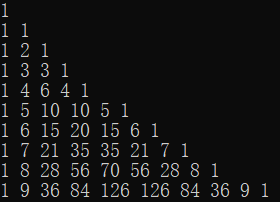目录
4.随机产生1-10的数字组成一个长度为10的数组,保证不重复
数组使用注意事项和细节
1) 数组是多个相同类型数据的组合,实现对这些数据的统一管理
2) 数组中的元素可以是任何数据类型,包括基本类型和引用类型,但是不能混用。
3) 数组创建后,如果没有赋值,有默认值
int 0,short 0, byte 0, long 0, float 0.0,double 0.0,char \u0000,boolean false,String null
4) 使用数组的步骤 1. 声明数组并开辟空间 2 给数组各个元素赋值 3 使用数组
5) 数组的下标是从 0 开始的。
6) 数组下标必须在指定范围内使用,否则报:下标越界异常,比如 int [] arr=new int[5]; 则有效下标为 0-4
7) 数组属引用类型,数组型数据是对象(object)
1.找出数组里的最大值,并显示下标
int[] scores = {4,-1,9,10,23};
int max = scores[0];
int maxIndex = 0;
for(int i = 1 ;i<scores.length;i++){
if(max<scores[i]){
max = scores[i];
maxIndex = i;
}
}
System.out.println("最大值为:"+max);
System.out.println("最大值对应的下标为:"+maxIndex);
2.数字里插入一个数并保证升序
int num = 23;
int index=-1;
int[] arr ={10,12,45,90};
int[] arr2=new int[arr.length+1];
for(int i = 0;i<arr.length;i++){
if(arr[i]>num){
index = i;
break;
}
}
if(index == -1){
index = arr.length;
}
for(int i=0,j=0;i<arr2.length;i++){
if(i!=index){
arr2[i]=arr[j];
j++;
}else{
arr2[i]=num;
}
}
arr = arr2;
System.out.println("===排序后===");
for(int i = 0;i<arr.length;i++){
System.out.print(arr[i]+"\t");
}
3.二维数组经典问题--杨辉三角
int[][] arr = new int[10][];
for(int i =0;i<arr.length;i++){
//给每个一维数组(行)开空间
arr[i] = new int[i+1];
//给每个一维数组(行)赋值
for(int j = 0;j<arr[i].length;j++){
//每一行的第一个元素和最后一个元素都是1
if(j==0||j==arr[i].length-1){
arr[i][j]=1;
}else{
arr[i][j]= arr[i-1][j] + arr[i-1][j-1];
}
}
}
for(int i = 0;i<arr.length;i++){
for(int j =0;j<arr[i].length;j++){
System.out.print(arr[i][j]+" ");
}
System.out.println();
}
4.随机产生1-10的数字组成一个长度为10的数组,保证不重复
static Random ran = new Random();
static int SIZE = 10;
static int index = 0;
static int target = 0;
static int[] a = new int[SIZE];
public static void main(String[] args) {
long s1 = System.nanoTime();
while (index < SIZE) {
int t = ran.nextInt(10) + 1;
boolean f = hasNum2(t);
if (!f) {
a[index++] = t;
}
}
long s2 = System.nanoTime();
System.out.println("耗时" + (s2 - s1));
print();
}
public static boolean hasNum2(int t) {// bitmap
int shift = 1; // 00000000 00000000 00000000 00000001
shift = shift << t; // 00000000 00000000 00000000 00000100
if ((shift & target) == 0) {
target = target | shift;
return false;
} else {
return true;
}
}
public static void print() {
for (int t : a) {
System.out.print(t + " ");
}
}总结:在调用hasNum2的里,运用的bitmap的编程思想,即位运算符,即可快速实现产生的随机数是否重复,大大缩短了运行时间。
在调用print方法时,运用了for...each循环可以缩减代码。
5.方法和数组的巧妙结合(学生成绩输入系统)
static Scanner sc = new Scanner(System.in);
static String[][] students = new String[3][4];
static int index = 0;
static int total = 0;
public static void main(String[] args) {
add();
add();
add();
add();
add();
print();
System.out.println();
System.out.println(scoreTotal());
System.out.println(avg());
System.out.println(passNum());
}
public static int scoreTotal() {
for (int i = 0; i < index; i++) {
total += Integer.parseInt(students[i][3]);
}
return total;
}
public static double avg() {
return 1.0 * total / index;
}
public static int passNum() {
int num = 0;
for (int i = 0; i < index; i++) {
int score = Integer.parseInt(students[i][3]);
if (score >= 60) {
num++;
}
}
return num;
}
public static void add() {
if (index >= students.length) {// 数组扩容
int newLength = students.length + (students.length >> 1);
String[][] ss = new String[newLength][4];
System.arraycopy(students, 0, ss, 0, students.length);
students = ss;
}
/**
* 信息输入
*/
System.out.print("请输入学生姓名:");
String name = sc.nextLine();
System.out.print("请输入学生科目:");
String subject = sc.nextLine();
System.out.print("请输入学生成绩:");
String score = sc.nextLine();
String studNum = "dyit" + System.currentTimeMillis();
String[] stu = { studNum, name, subject, score };
students[index++] = stu;
}
public static void print() {
System.out.println(Arrays.deepToString(students));
}




















 230
230











 被折叠的 条评论
为什么被折叠?
被折叠的 条评论
为什么被折叠?








